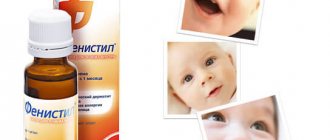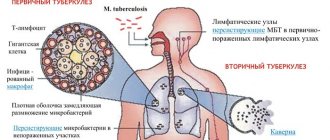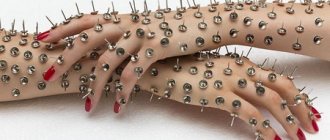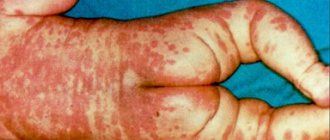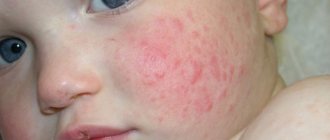When teeth start cutting
There is no exact answer as to what time a child’s teeth are cut – the timing varies from person to person. However, you can focus on the average, standard periods of eruption approved by WHO:
- the lower incisors appear at 6–7 months;
- upper – at 7–8 months;
- upper lateral incisors – at 8–9 months;
- the lower ones are closer to a year.
According to the standard, a one-year-old child must have eight baby teeth.
From one year to one and a half years, the child acquires larger teeth - upper and lower molars, and from fifteen to twenty months - upper canines, which are also called “ocular.” The fact is that the optic nerve runs next to them, so these teeth are often more difficult for the child than others. Irritation of the nerve causes sharp pain and sometimes watery eyes.
It can be difficult even for a doctor to understand that the first teeth are being cut. After all, this process is often accompanied by an increase in temperature, changes in stool and mood, and refusal to eat.
Associated symptoms - features of the process
Teething is accompanied by a number of symptoms:
Let us consider in more detail the features of the symptoms, so as not to confuse teething with the development of any diseases.
The gums become inflamed because the edge of the tooth cuts the dental tissue. When the gums swell, the baby is eager to scratch it, so he puts everything he can into his mouth.
During this difficult time, the baby is very capricious. He hardly sleeps and cries constantly. You need to take him in your arms, sing to him or just talk to him. Avoid any loud noises in your home, turn off the TV. You can turn on regular, classical music to make the child fall asleep.
Read also: Abscess on a child’s gum
Inflamed gums can cause fever. If within two days it stays within 38.5, then this is normal. If it rises higher and fever begins, this means the presence of other diseases.
Having a runny nose and cough is also normal. This happens due to the secretion of saliva, which enters the nasopharynx, irritates it and causes a cough. It is slightly moist, infrequent and accompanied by salivation. The nose should not be stuffy if a runny nose or cough is different - these are signs of another disease.
When cutting through, the baby may not want to eat or stomach upsets, vomiting, diarrhea and others may occur. When the process is over, everything will return to normal.
If the baby is breastfed, he may refuse it or ask for even more. The stool becomes heavier or diarrhea begins.
Formation of the dentition
The article tells how to understand that a child is teething, and about ways to help him with pain and inflammation of the gums. But first, a few words about the process of dentition formation.
The formation of absolutely all teeth occurs in the fifth month of intrauterine development. They remain in a “frozen” state and begin to grow immediately before eruption. Therefore, if a child has no teeth by 9-12 months, radiography is prescribed - a study that allows one to evaluate their formation and location.
How to treat swollen gums
Treatment of inflamed gums begins with identifying the cause of the disease. To do this, an X-ray of the jaw and an examination of the oral cavity are performed.
Further tactics depend on the established diagnosis. If surgical intervention is necessary (opening an abscess, removing a cyst), it is performed immediately. The patient is anesthetized in the dentist's chair, and then all necessary manipulations are performed.
After surgical treatment, maintenance drug therapy is prescribed. It allows you to avoid the development of complications. Most often, the patient is prescribed rinsing with an antiseptic solution and taking anti-inflammatory drugs. Antibiotics are sometimes recommended to prevent bacterial complications. They should be taken only as prescribed by a doctor, and exactly the drug that is indicated in the prescription. This is important to achieve a guaranteed positive effect.
Some drugs do not combine with each other. Therefore, uncontrolled use of medications can harm the patient himself. If you choose the wrong antibiotic, the bacteria will not only not die, but will also develop resistance to the drug. Then it will take a long time to select a suitable remedy, which will complicate the patient’s life - it will no longer be possible to quickly get rid of unpleasant symptoms.
Rinse recipes
The patient's attending physician should prescribe rinses. They are not allowed for all diseases. After surgical treatment, rinsing too hard can cause the suture to come apart. An infection or food particles will get into an open wound, which will cause new inflammation and suppuration.
It is impossible to completely cure swollen gums with rinses. But they are advised to be combined with drug treatments to alleviate the condition and enhance the effect of the drugs.
- Decoctions of medicinal herbs: chamomile, calendula, lemon balm, sage, St. John's wort. Some components can cause allergies, so you need to be careful with them. However, they have a mild anti-inflammatory effect and can help relieve swelling and reduce inflammation.
- Propolis tincture - dilute it with warm water and rinse your mouth 2 times a day. The product helps against ENT diseases (sore throat and sinusitis), which often develop into inflammation of the gums.
- Soda and salt - add 1 teaspoon of each powder to a glass of warm water and stir. The product has a wound healing effect and helps stop bleeding gums.
In addition to rinsing, lubricating the area of inflammation with tea tree or fir oil is also effective. They have an anti-inflammatory and wound-healing effect. However, they should not be applied to the site of suppuration. It is also worth considering the risk of plant allergies.
There are many reasons for gum swelling, not all of them are obvious. Only a doctor after diagnosis can figure out what caused the inflammation. Independent attempts to cure the disease often lead to serious complications, so you should not expect that the swelling on the gums will go away on its own. It is better to visit a doctor and make sure there are no risks or get competent and timely treatment.
What affects the timing of teething?
Processes in the body are individual, including timing. The age at which the first teeth appear is determined by a number of factors:
- Heredity.
- The intrauterine period and negative factors affecting the fetus (for example, a pregnant woman taking certain medications).
- Nutrition for the expectant mother during the period of waiting for the baby and breastfeeding.
Introduction of complementary foods, etc.
When to see a doctor?
If any of the above symptoms appear, it is better to call a pediatrician at home or come to an appointment at the clinic and show the child to a doctor. He will conduct a study and rule out or confirm another cause of such negative symptoms, which may or may not be related to teeth.
However, there are more dangerous symptoms for which a pediatrician cannot be avoided. In particular, doctors include several main symptoms as dangerous signs that should never be ignored:
- The physiological process is accompanied by severe coughing attacks. In particular, excessive salivation and a large amount of saliva will flow down the throat and provoke coughing attacks in the child. The baby's cough reflex attacks will intensify when lying down - it will become wet and intrusive, and will interfere with sleep and eating. Parents may suspect an infectious lesion of the body - a cold, and in this case its attacks will last more than 2-3 days. May be accompanied by shortness of breath and difficulty breathing - this may indicate inflammation of the upper respiratory tract.
- Copious discharge from the nasal passages - normally it should be clean and transparent, like water. Such symptoms most often go away after 2-3 days - just rinse the nasal passages with a salt solution. If an infectious process develops, the nasal discharge will be quite abundant, its color will become yellowish or greenish, and last more than 4 days.
- Excessive saliva production in a baby can provoke stool upset - when it gets into the digestive tract, it accelerates intestinal motility and provokes diarrhea 2-3 times a day. When an infectious process occurs in the body, diarrhea will bother the child more than 3 times a day, interspersed with mucus and blood. Thus, inclusions in the stool of blood can indicate intestinal infections and disorders of the digestive system.
In such cases, it is worth taking the child to the dentist. It is also worth taking your baby to a specialist in case of not only prolonged diarrhea and the threat of dehydration, but also in case of the exact opposite phenomenon - constipation. If a child’s immunity is weakened, during teething he may develop diseases of the oral cavity.
Most often the following pathologies show themselves negatively:
- Thrush - it is provoked by a fungus from the genus Candida and is classified as a fungal disease that develops against a background of weakened immunity. In this case, the child’s gums and tongue will be covered with a whitish coating , itching, decreased appetite, and increased pain will appear.
- The development of stomatitis in a child - ulcers and wounds can cover the oral cavity , causing the baby a lot of anxiety.
In such cases, it is worth showing the child to a pediatrician - this will eliminate any negative consequences and give advice on how to alleviate the baby’s general condition at this stage of its development. This will help both the baby and the parents, and all negative symptoms can be overcome easily and without any special difficulties.
Teething symptoms
- there may be a slight fever;
- anxiety - the child becomes capricious, sleeps poorly, often wakes up at night;
- decreased appetite;
- excessive salivation and, as a result, redness of the skin around the mouth;
- swelling and redness at the site of tooth eruption, possible formation of hematomas on the gum mucosa;
- increased need for the baby to chew on something: pacifier, toys, fingers.
There are children whose teeth appear asymptomatically and even unnoticed by their parents. But, as a rule, this process is accompanied by an individual combination of the signs given in the list above.
White gums in an infant: do they need treatment?
- Natal and neonatal teeth . Sometimes it happens that a child is born with teeth already erupted. To decide whether it is advisable to preserve them, you should contact your dentist. Around six months, baby teeth begin to emerge, but this can happen several months earlier. The tooth at the eruption stage looks like a small white dot.
- Calcium deficiency in a child's body is another reason why a newborn may have white plaque on the gums. This occurs due to poor nutrition or congenital deficiency of the mineral.
- Bon's knots . If the mother notices small white protruding dots on the baby’s gums, then perhaps these are Bon’s nodules. These formations are small cysts that do not require treatment or removal, as they do not pose a threat to the life and development of the child.
- Stomatitis . A common phenomenon, especially at an age when a child begins to actively explore the world through the oral cavity, that is, to drag any objects into his mouth. Infectious agents found on toys, dishes or pacifiers can land on the baby’s gums, which leads to the development of the disease. A characteristic sign of thrush, or candidiasis in other words, is a white coating covering reddened mucous membranes. For treatment, you should seek medical help. Read more about stomatitis in infants→
Read also: Treatment of pus in the gums
Also, white gums in a small child may indicate such serious conditions as HIV infection, cancer, diabetes, but this is rare, so there is no need to immediately panic, but it is better to consult a dentist or pediatrician to determine the true causes.
The order of appearance of teeth
Despite the existing features and differences in children when their first teeth appear, the patterns and order of teeth appearance are still similar, taking into account the fact that some parents are concerned about the question of whether there are differences between boys and girls in the order of appearance and growth of teeth, how teeth are cut in boy and a number of others.
It is worth noting that the pattern of teeth appearance is the same and does not depend on the gender of the baby.
How to help your baby?
Pediatricians say that most children experience teething relatively painlessly, and the condition does not require intervention. However, you can help your baby and his teeth a little:
- Buy rubber and silicone teethers
. Some of them can be cooled in the refrigerator - cool material reduces discomfort. - Some children prefer to chew and suck on tissue
. Give your baby a few pieces to chew on. Don't forget to wash them daily. - Massage your baby's gums with a clean finger or silicone toothbrush
. - If your baby constantly cries and cannot fall asleep, consult your pediatrician and ask him to find a remedy to relieve pain. Remember that such medications intended for infants can only be given from six months.
- The pediatrician may also recommend special gels that relieve pain and swelling
in the baby's mouth. Don't overuse these remedies: Many parents confuse teething symptoms with other problems, such as viral infections, ear diseases or sleep disturbances.
Healthy habits - from childhood
By the age of three, a child can learn basic self-care skills. Find out how to teach your child good personal hygiene.
Pericoronitis, symptoms and types
With pericoronitis, the symptoms largely depend on the form of the disease - acute or chronic. Acute pericoronitis is characterized by:
- Aching intense pain in the area of the cutting tooth, the pain intensifies under the influence of food and mechanical irritants (hygienic procedures, chewing, touching, etc.).
- Difficulty chewing food, complicated swallowing. A few days after the onset of inflammation, it becomes difficult to open the mouth and severe pain appears.
- Swelling and hyperemia of the mucous membrane.
- Enlargement of regional lymph nodes, sometimes the lymph nodes become painful when touched.
- Externally noticeable swelling of the cheeks a few days after the onset of the inflammatory process.
- General deterioration in health - weakness, lethargy, prolonged low-grade fever (increased temperature to 37-37.5 degrees).
- Bad breath, which is caused by the decomposition of food particles and the active activity of microorganisms in the “hood” space.
Acute pericoronitis can occur in a serous (catarrhal) or purulent form: in the first case, the signs of inflammation are more pronounced, the pain is more intense, and there is no purulent discharge. In the second case, purulent exudate flows freely from the inflammatory focus, due to which tissue tension is somewhat reduced and the symptoms are less pronounced. A person may feel like their condition is gradually improving, when in fact the infection is simply spreading to other tissues in the mouth.
If treatment for acute pericoronaritis was not carried out or was carried out at home, the disease gradually becomes chronic: the severity of symptoms decreases, while exacerbations of pain and discharge of pus into the oral cavity are periodically observed. In this case, there is a high risk of developing severe complications.




